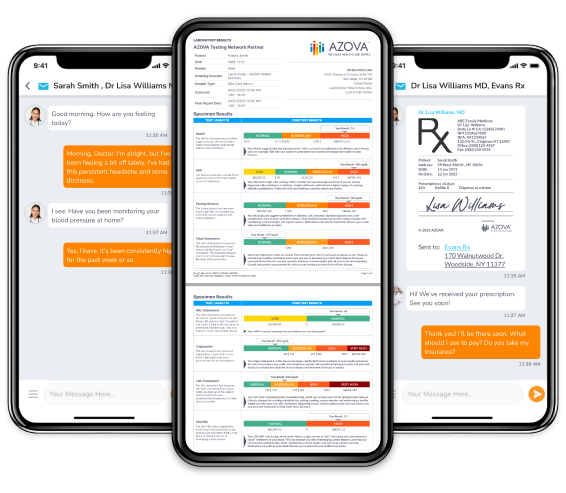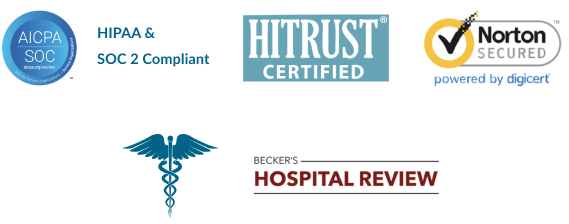Reliable pink eye treatment, just a click away.
Connect with a board-certified healthcare provider for pink eye relief via a quick, secured video visit or messaging. Receive a diagnosis and treatment plan, all without leaving home.
Available in all 50 states.

Understanding pink eye
Pink eye, or conjunctivitis, is a common inflammation of the eye’s outer layer, the conjunctiva. It often causes redness, itchiness, a gritty sensation, and watery discharge.
Types of pink eye
- Viral conjunctivitis is commonly caused by a cold virus, and is highly contagious, often accompanied by cold symptoms.1-4
- Bacterial conjunctivitis is caused by bacteria, and may involve a thicker discharge, sometimes with a yellow or green color.1-4
- Allergic conjunctivitis often occurs in people with allergies and is triggered by allergens like pollen or pet dander.1-4
- Newborn pink eye (Ophthalmia neonatorum) is often caused by infection, blocked tear ducts, or irritation from birth treatments.1-4
- Giant papillary conjunctivitis (GPC) develops due to prolonged contact lens wear or irritation from eye surgery.3-4
- Chemical conjunctivitis occurs when eyes are exposed to irritants like pollutants, pool chemicals, or harsh substances.3-4
While pink eye can be uncomfortable, it’s usually not serious and often clears up on its own. However, if symptoms persist for more than a week, worsen, or cause vision changes, consult a professional healthcare provider.
- Pink eye symptoms in adults
- Pink eye symptoms in children
- Pink eye causes in adults
- Pink eye causes in children
- Pink eye treatments for adults
- Pink eye treatments for children
Pink eye symptoms in adults
Pink eye can cause a variety of uncomfortable symptoms in adults. These can include:1-3
- Redness: This is a telltale sign of pink eye, and the whites of your eyes may appear inflamed or bloodshot.
- Itchiness: Your eyes might feel intensely itchy, making it tempting to rub them (which can actually worsen symptoms).
- Gritty sensation: It can feel like you have sand or other particles stuck in your eyes.
- Watery discharge: Your eyes might produce more tears than usual, causing a watery feeling and discharge.
- Sensitivity to light: Bright lights or sunlight may feel uncomfortable or even painful.
- Eyelid swelling: In some cases, your eyelids may become puffy or swollen.
- Blurred vision: This is less common, but some adults with pink eye may experience temporary blurry vision.
Pink eye symptoms in children
Little ones can’t always tell you exactly what’s wrong with their eyes. Here’s what to watch out for if you suspect your child might have pink eye:1
- Redness: Similar to adults, the whites of your child’s eyes may appear red or inflamed.
- Swelling: Their eyelids might be puffy or swollen, especially when they wake up in the morning.
- Increased tearing: Pink eye can cause excessive tear production, making your child’s eyes appear watery.
- Eye rubbing: If your child is constantly rubbing their eyes, it could be a sign of discomfort caused by pink eye.
- Discharge: Depending on the type of pink eye, your child might have a watery, clear discharge, or a thicker, yellow or green discharge.
- Fussy behavior: Pink eye can cause discomfort and irritation, making your child cranky or fussy.
Pink eye causes in adults
Understanding the root cause of pink eye is essential for effective treatment. The common factors in adults that can lead to this eye condition may include:
- Viral infections: Highly contagious, often caused by the common cold virus. Symptoms typically include redness, itchiness, and watery discharge.1-3
- Bacterial infections: Can result in a thicker, pus-like discharge. Antibiotics are often necessary for treatment.1-3
- Allergies: Triggered by allergens like pollen, pet dander, or dust mites, leading to itchy, watery eyes.1-3
- Contact lens-related issues: Improper care or overuse of contact lenses can lead to inflammation.1-3
- Dry eye syndrome: Reduced tear production can contribute to pink eye-like symptoms.1-4
Pink eye causes in children
Understanding the root cause of pink eye is essential for effective treatment. The common factors in children that can lead to this eye condition may include:1-3
- Viral infections: Highly contagious, often caused by the common cold virus. Symptoms typically include redness, itchiness, and watery discharge.
- Bacterial infections: Can result in a thicker, pus-like discharge. Antibiotics are often necessary for treatment.
- Allergies: Triggered by allergens like pollen, pet dander, or dust mites, leading to itchy, watery eyes.
- Blocked tear ducts: Common in newborns, preventing proper drainage and leading to eye irritation.
- Exposure to irritants: Babies and young children are more susceptible to eye irritation from shampoos, soaps, or other products.
Pink eye treatments for adults
Pink eye treatments focus on relieving symptoms, combating infection, and preventing spread. Specific treatment options may vary depending on the cause of the condition.
- Viral conjunctivitis
Typically resolves on its own; artificial tears may provide comfort.2-4 - Bacterial conjunctivitis
Requires antibiotic eye drops or ointments prescribed by your doctor.2-4 - Chemical conjunctivitis
Flush eyes with saline; may need topical steroids. Consult your doctor immediately for severe cases.2-4 - Allergic conjunctivitis
Manage allergens, use over-the-counter antihistamine eye drops. Consider prescription medication for severe cases.2-4 - Giant papillary conjunctivitis
Often linked to contact lens use. You may require switching contact lens type or solution. You may need to discontinue use and seek professional advice.2
When to seek medical attention
In-person care
If you experience persistent or worsening symptoms, such as significant pain, vision changes, or light sensitivity, or if you notice any signs of complications like discharge with a yellow or green color or excessive swelling, it’s essential to seek immediate medical attention.
AZOVA Virtual Urgent Care
Virtual Urgent Care can be a convenient option for discussing symptoms and getting advice for mild pink eye cases or follow-up appointments.
Pink eye treatments for children
- Viral conjunctivitis
Often clears up on its own; cool or warm compresses can soothe discomfort.2-4 - Bacterial conjunctivitis
Requires antibiotic eye drops or ointment; consult a pediatrician for proper administration.2-4 - Chemical conjunctivitis
Identify and avoid allergens; use over-the-counter children’s antihistamine eye drops if recommended.2-4 - Allergic conjunctivitis
Immediately flush eyes with clean water and seek medical attention.2-4 - Newborn conjunctivitis
Requires immediate medical attention; avoid self-treatment.2
When to seek medical attention3
In-person care
If your child is experiencing severe symptoms of pink eye, such as significant pain, vision changes, or light sensitivity, it’s essential to seek immediate medical attention. Additionally, if you notice any signs of complications, like discharge with a yellow or green color, or excessive swelling, consult a healthcare professional immediately. For newborns with pink eye, immediate medical attention is crucial.
AZOVA Virtual Urgent Care
Virtual Urgent Care can be a convenient option for discussing symptoms and getting advice for mild pink eye cases or follow-up appointments.
Don’t suffer through red, itchy eyes. Get treatment for pink eye today.
References
1Centers for Disease Control and Prevention. (2024, April 15). Symptoms of Pink Eye. https://www.cdc.gov/conjunctivitis/signs-symptoms/index.html
2WebMD. (2024, April 9). Pink Eye: What You Should Know. https://www.webmd.com/eye-health/eye-health-conjunctivitis
3American Optometric Association (AOA). (n.d.). Conjunctivitis (pink eye). https://www.aoa.org/healthy-eyes/eye-and-vision-conditions/conjunctivitis?sso=y
4National Eye Institute. (last updated 2023, November 15). Pink eye. National Institutes of Health. https://www.nei.nih.gov/learn-about-eye-health/eye-conditions-and-diseases/pink-eye#section-id-870
Need help or have questions?
Contact our AZOVA Customer Support team below
Live 24/7 chat
(quickest response)
You can chat with AZOVA’s Customer Support team for comprehensive support, including help with your account, testing, shipping, and results.
We typically respond within 5 minutes. Click the messaging icon on the lower right corner of the page to get started.



